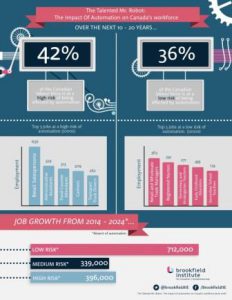Brookfield Institute for Innovation + Entrepreneurship releases most comprehensive report to date assessing how automation will impact future employment in Canada. Around the World also!
Automation is transforming traditional occupations, changing the day-to-day tasks of Canadians, and potentially creating new jobs, states new research from the Brookfield Institute for Innovation + Entrepreneurship (BII+E) at Ryerson University. The report just released entitled The Talented Mr. Robot: The Impact of Automation on Canada’s Workforce analyzes automation and how it will directly affect the Canadian labour market over the next 10 to 20 years.
For years, automation has been restricted to routine, manual tasks. The more recent rise of artificial intelligence and advanced robotics means that automation is now entering the realm of cognitive, non-routine tasks and occupations, such as driving and conducting job interviews.
« Our findings show that a significant percentage of Canadian jobs are at a high risk of being replaced by automation over the next 10 to 20 years (…) However, we don’t believe that all of these jobs will be lost. Many will be restructured and new jobs will be created as the nature of occupations change due to the impact of technology and computerization », said Sean Mullin, Executive Director of BII+E.
Jobs that are considered to be at a low risk of automation are linked to high skill levels and higher earnings, such as management and jobs in science, technology, engineering and math (STEM), which are expected to create many new jobs for Canadians in the coming years.
Report Key Findings
- Nearly 42% of the employed Canadian labour force is at a high risk of automation over the next 10 to 20 years.
- The vast majority of high-risk occupations are in office support and general administration, sales and services, transportation and distribution, lower skilled technical occupations in health, natural and applied sciences, as well as manufacturing and construction labourers and assemblers.
- Approximately 36% of Canada‘s employed labour force is at a low risk of automation. Using the Canadian Occupation Projection System (COPS), occupations with the lowest risk of being affected by automation are projected to produce nearly 712,000 new jobs between 2014 and 2024.
- Ontario has the lowest proportion of jobs at high risk of automation, and Prince Edward Island the highest with over 45% at of jobs at high risk of automation over the next 10 to 20 years.
Also included as part of the report, is an interactive and downloadable tableau visualization for jobs likely to be automated. It portrays every occupation studied as part of the report, segmented by income, current percentage of the Canadian labour force, and probability of automation.
BII+E is a new independent and nonpartisan institute, housed within Ryerson University, that is dedicated to making Canada the best country in the world to be an innovator or an entrepreneur.

